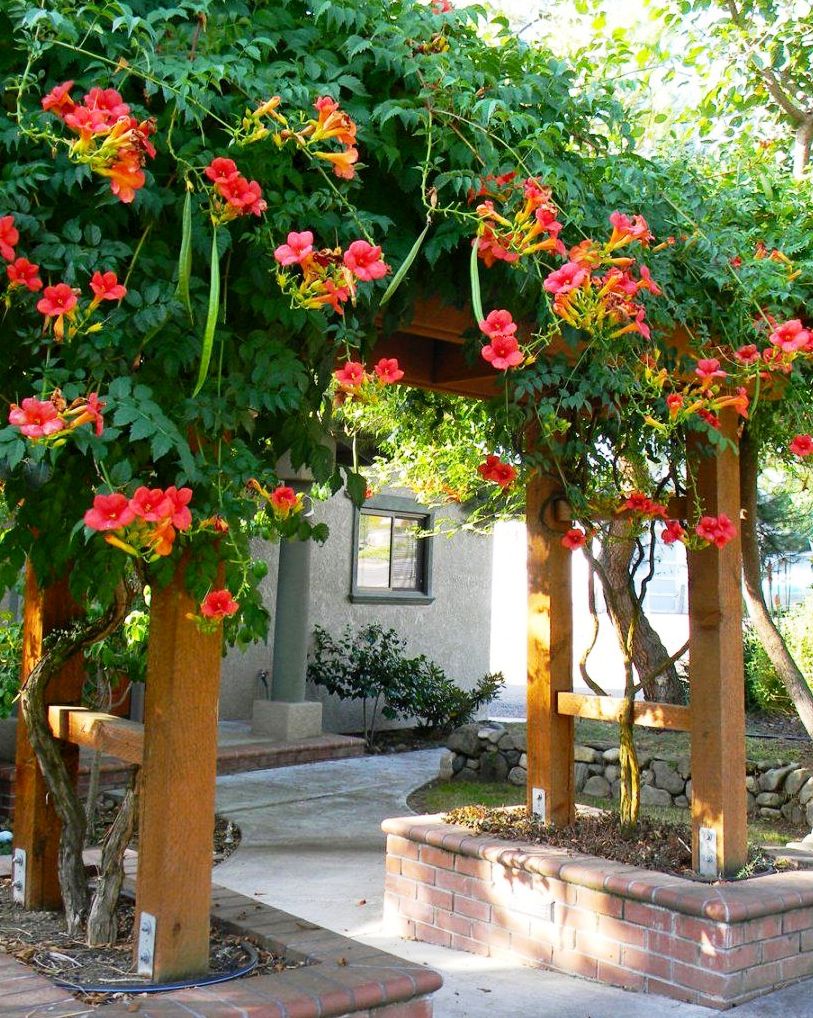by Ken Lain, the mountain gardener
Large clusters of reddish flowers create a dramatic show all season long.
Once established, this vigorous vine thrives in heat and blooms profusely with neglect. Quickly covers large areas as a ground cover, spilling over retaining walls, screening a fence, or cloaking arbors. Guaranteed to attract more hummingbirds.

Birdwatchers often plant trumpet vine because its orange flower attracts hummingbirds.
The compound leaves are large (up to 15 inches) and vibrant green on the top surface and lighter green underneath. The foliage is pinnately compound with leaves divided into multiple leaflets, and the overall look is a feather texture. Clusters of trumpet-shaped yellow, orange, or red flowers up to three inches long appear from June to September. Leaves turn autumn gold in fall. After the flowers, six-inch-long seed pods appear.
Trumpet vine provides quick cover for fences, arbors, trellises, walls, and other structures. It can also blanket the ground to hide rock piles and refuse heaps. It is an excellent vine for hot, dry conditions, but it needs lots of room. The best vine for hummingbird gardens.
Botanical Name: Campsis radicans
Common Name: Trumpet vine, trumpet creeper, hummingbird vine
Plant Type: Deciduous woody vine
Mature Size: 30′ feet
Sun Exposure: Full sun to part shade
Soil Type: Grows in any soil; prefers well-drained soil
Soil pH: 3.7 to 6.8
Bloom Time: June to September
Flower Color: Yellow, orange, red
Hardiness Zones: 4 to 9
Native Area: Southeastern U.S. but naturalized in many states
How to Grow Trumpet Vine
Trumpet vine prefers well-draining soil but grows in almost any soil in the hot sun. This vine likes to creep over the ground, up trees, arbor, and pergolas that requires little care once established.
The most important maintenance is to prune them back, frequently and aggressively, to keep the vines under control. Faithfully pull up any new shoots that pop up from the root system.
Light
Trumpet vines thrive in 6+ hours of sun. The all-day sun produces the best flowers.
Soil
These vines do well in almost any soil, but they grow most aggressively in well-drained soils.
Trumpet vine needs water when there are apparent signs of withering. Treat the vine as you would any tree in the landscape and water accordingly.
Temperature and Humidity
Trumpet vine’s natural range is the hot, humid regions of the Southeast. In dryer Arizona climates, the plant is more natural to control.
Fertilizer
Feed with 7-4-4 All Purpose Food three times per year for amazing flowers. This natural food is spread like salt-and-pepper around the bush base every Easter, July 4th, and Halloween for incredible results.
Trumpet Vine ‘Aurea’: This cultivar produces yellow flowers.
Trumpet Vine ‘Flava‘: This is another yellow-flowering cultivar.
Trumpet Vine ‘Madame Galen‘ is covered in pumpkin orange flowers and far less aggressive.
Trumpet Vine ‘Summer Jazz‘ has the brightest reds.
Common Problems
There are virtually no disease and pest issues that plague trumpet vine. Where the plant becomes too much to handle, there are four natural methods recommended for killing it:
Not enough sun
Pruning at the wrong time: Trumpet vine blooms on new growth, so pruning should be done before new growth begins in spring.
Toxicity of Trumpet Vine
There is a skin irritant in trumpet vine that affects some people. This characteristic lends trumpet vine one of its common names—cow itch vine. It’s also the reason deer, elk and javelina distaste even the flowers.
Pruning
This is a plant for which it is almost impossible to prune too much. Before new growth starts to grow in March, cut this vine back aggressively, leaving only a few buds. Again, Trumpet vine flowers best on new wood and is pruned similarly to a grapevine. This kind of aggressive annual pruning is the best way to keep the plant in check.

